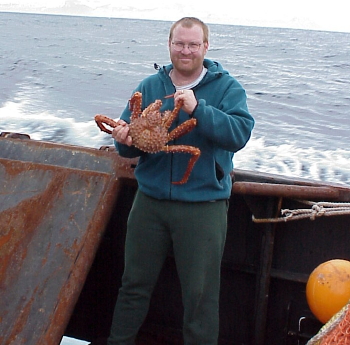|
General FAQs on EDRs can be found at http://www.fakr.noaa.gov/sustainablefisheries/crab/rat/edr/default.htm
Catcher Vessel Questions
Table 5
5.1 a. Insurance Premiums: I am in an insurance pool for the hull and machinery of my boat. I pay 5% of the value of those items and that money is invested in the stock market. I am starting to get dividends back from the investments that are pretty much paying for my premiums. Do I report the cost I pay to make up the premiums or what the cost would be if I didn't hve those dividends paying part of the premium?
You should report the net/true cost of insurance (the premium you pay less any dividends you received for the year).
Do I need to isolate the amount of insurance that applies to just the BSAI crab or record the total for the whole year?
Use table5.2c "Other vessel specific costs", write in insurance and the amount for the year, and check the box "Cost related to more than just crab fishing?" to indicate that it is a cost for more than just crab fishing.
Use table 5.2 for any costs that are not solely attributable to crab fishing. If you can't get the amount of fuel you used for the crab fishery, record your total fuel cost in table 5.2.
Do I record the amount of bait purchased or the amount used?
Record the amount purchased for the fishery and the total cost of what you bought.
Table 5.1 n: The table asks for crab specific costs but letter n. asks
for fish taxes. I have fish and crab so do I report the sum of both fish
and crab taxes or, because the table is for crab costs only, do I report
just crab taxes?
Yes, you should be reporting crab taxes, not all fish taxes.
Table 5.2, What would capitalized expenditures be and what are considered significant costs? What is significant to one persons operation will be different for another's.
"Capitalized expenditures" are those that are financed/paid for by
borrowing money and are typically depreciated over time. These
expenditures differ from the "repair and maintenance" expenses we ask for
right below them, in that capitalized expenditures are typically larger,
less frequent types of improvements or modifications to a vessel, and repair
and maintenance expenses are incurred on a regular basis and paid for out of
the operating revenues of the vessel.
Table 6
Table 6.0 is for all fisheries, what about when I chartered the boat out for survey (mapping) work for part of the year? What about tendering?
Table 6.0 is supposed to be representative of how you handled crew expenses when fishing for crab in BSAI crab fisheries. Ignore the survey
work and because tendering is not directly harvesting, ignore that as well.
Table 6, what is the difference between "Deducted" and "Directly
Charged". I deduct costs for freight and food from the crew but
what does it mean to directly charge them for something?
Typically crew get a certain percentage of revenues earned on the trip (for example, $100,000). However, some of the expenses are "taken off the top" of the revenue pie before the respective shares are given to the boat, skipper, and other crew (these expenses might include fuel, bait, and groceries). Such expenses are thus shared by both the crew and vessel owner (assume in this example this is $40,000). We now have a quantity of net revenue (here, $60,000) that is split according to the shares each group gets.
However, other deductions may still occur from each crew member's settlement. These would be the "directly charged" items. For example, the company may have paid to fly someone up to AK, or given them a cash advance, or paid for some of their medical services. These amounts need to be reimbursed to the company out of the crew member's settlement (and are not shared or taken off the top of everyone's overall revenue pie).
So -- deducted means taken off the top (subtracted from total revenues of both the boat and crew before crew share is calculated - implying that both boat and crew share the cost of that expense).
Directly charged means that the charge is assessed to the crew member after their share has been calculated so that the individual can pay back the vessel for specific items.
Table 7
Table 7.0: In reporting gross revenue, should I include charter work (surveying) or tendering that is not harvesting related?
No, only record harvesting related activity.
Do you want the labor costs for all fisheries combined?
Yes, Table 7 labor costs are for all fisheries combined, the amount actually paid to the captain and crew, after expenses are taken out (their take-home pay).
Catcher Processor Questions
Table 5
We do not have FOB Alaska prices but FOB Seattle (or another location), what do we do?
If you do not record your sales revenue on an FOB Alaska basis (as requested in Table 5.0), please provide the sales revenue from each product and list the state and city where you ship FOB at the top of the table. For example, if your sales revenue reflects FOB Seattle, WA prices, record those revenues and mark on the page that it is a Seattle, WA location. If for some reason your records reflect more than one FOB location (e.g., you ship from both Alaska and Seattle, WA), please attach a copy of page 24 with the non-Alaska FOB revenues and the location of those revenues indicated
Table 6
Do I record the amount of bait purchased or the amount used?
Record the amount you purchased for the fishery and the total cost of what you bought.
|
